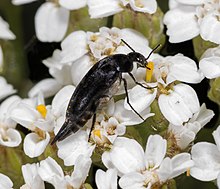Mordellini
| Mordellidae | |
|---|---|
 |
|
| Mordella aculeata; note the "pintail" | |
| Scientific classification | |
| Kingdom: | Animalia |
| Phylum: | Arthropoda |
| Class: | Insecta |
| Order: | Coleoptera |
| Superfamily: | Tenebrionoidea |
| Family: |
Mordellidae Latreille, 1802 |
| Subfamilies | |
|
|
| Synonyms | |
|
Liaoximordellidae |
|
Liaoximordellidae
The Mordellidae are a family of beetles commonly known as tumbling flower beetles for the typical irregular movements they make when escaping predators, or as pintail beetles due to their abdominal tip which aids them in performing these tumbling movements. Worldwide, there are about 1500 species.
The apparently tumbling movements are composed of a series of very rapid separate jumps (each jump of a duration of approximately 80 ms). They result from the beetle's efforts to get itself back into take-off position for flight when it has been in either lateral or dorsal position. Each individual jump should be considered as an extended rotation, performed by one leg of the third leg pair (metapodium). Depending on whether the left or the right metapodium is used as the leg that provides the leverage for take-off, change occurs in the direction of the jump. The energy for propulsion varies with the beetle's immediate muscle work, so that jump lengths and heights vary, with rotation frequencies recorded up to 48 per second (Mordellochroa abdominalis) around the gravitation centre of the body's longitudinal axis. Additional revolving around the transverse axis (at lower frequency) effects spiralling somersaults that are perceived as tumbling. The pintail (pygidium) is of no significance for the jump. While the pintail is no significance for the jump, meta-trochanter-femur (thighs and surrounding rings of the third leg pair)has a great capacity of free rotation (up to 270 degrees, at one level only). This capacity is due to a screw joint that connects the base of metacoxa to the head of trochanter. The nut gradient is 21 degrees (as seen under a scanning electron microscpoy SEM, 1985). Technically similar jumps, though less powerful, can be observed in family Melandryidae (=Serropalpidae) (genus Orchesia) and family Scraptiidae (genus Anaspis). Their coxa-trochanter-joints are of similar structure. It can be assumed that the capacity of a tumbling form of locomotion is rooted in a common phylogeny and can therefore not be ascribed specifically to Mordellidae. Meanwhile, other authors have also pointed out the uniqueness of the real screw joint in nature. (2011) The weevil of the genus Trigonopterus, Curculionidae in the Asian tropical rainforest, for example, has an even tighter connective construction in the Coxa -Trochanter joint than is found in Mordellidae. This construction, however, does not facilitate an equally high angular velocity of the torque. The joint here serves to provide a better grip on plants and easier climbing.
...
Wikipedia
